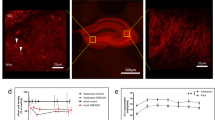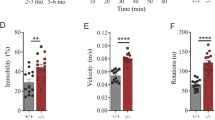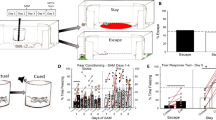Abstract
Pharmacological data suggest that delta opioid receptors modulate learning and memory processes. In the present study, we investigated whether inactivation of the delta opioid receptor modifies hippocampus (HPC)- and striatum-dependent behaviors. We first assessed HPC-dependent learning in mice lacking the receptor (Oprd1−/− mice) or wild-type (WT) mice treated with the delta opioid antagonist naltrindole using novel object recognition, and a dual-solution cross-maze task. Second, we subjected mutant animals to memory tests addressing striatum-dependent learning using a single-solution response cross-maze task and a motor skill-learning task. Genetic and pharmacological inactivation of delta opioid receptors reduced performance in HPC-dependent object place recognition. Place learning was also altered in Oprd1−/− animals, whereas striatum-dependent response and procedural learning were facilitated. Third, we investigated the expression levels for a large set of genes involved in neurotransmission in both HPC and striatum of Oprd1−/− mice. Gene expression was modified for several key genes that may contribute to alter hippocampal and striatal functions, and bias striatal output towards striatonigral activity. To test this hypothesis, we finally examined locomotor effects of dopamine receptor agonists. We found that Oprd1−/− and naltrindole-treated WT mice were more sensitive to the stimulant locomotor effect of SKF-81297 (D1/D5), supporting the hypothesis of facilitated striatonigral output. These data suggest, for the first time, that delta receptor activity tonically inhibits striatal function, and demonstrate that delta opioid receptors modulate learning and memory performance by regulating the HPC/striatum balance.
Similar content being viewed by others
Log in or create a free account to read this content
Gain free access to this article, as well as selected content from this journal and more on nature.com
or
References
Bannerman DM, Niewoehner B, Lyon L, Romberg C, Schmitt WB, Taylor A et al (2008). NMDA receptor subunit NR2A is required for rapidly acquired spatial working memory but not incremental spatial reference memory. J Neurosci 28: 3623–3630.
Bramham CR, Milgram NW, Srebro B (1991). Delta opioid receptor activation is required to induce LTP of synaptic transmission in the lateral perforant path in vivo. Brain Res 567: 42–50.
Chavkin C, Shoemaker WJ, McGinty JF, Bayon A, Bloom FE (1985). Characterization of the prodynorphin and proenkephalin neuropeptide systems in rat hippocampus. J Neurosci 5: 808–816.
Chefer VI, Shippenberg TS (2009). Augmentation of morphine-induced sensitization but reduction in morphine tolerance and reward in delta-opioid receptor knockout mice. Neuropsychopharmacology 34: 887–898.
Ciamei A, Morton AJ (2009). Progressive imbalance in the interaction between spatial and procedural memory systems in the R6/2 mouse model of Huntington's disease. Neurobiol Learn Mem 92: 417–428.
Dang MT, Yokoi F, Yin HH, Lovinger DM, Wang Y, Li Y (2006). Disrupted motor learning and long-term synaptic plasticity in mice lacking NMDAR1 in the striatum. Proc Natl Acad Sci USA 103: 15254–15259.
Deipolyi AR, Fang S, Palop JJ, Yu GQ, Wang X, Mucke L (2008). Altered navigational strategy use and visuospatial deficits in hAPP transgenic mice. Neurobiol Aging 29: 253–266.
Ding JB, Guzman JN, Peterson JD, Goldberg JA, Surmeier DJ (2010). Thalamic gating of corticostriatal signaling by cholinergic interneurons. Neuron 67: 294–307.
Durieux PF, Bearzatto B, Guiducci S, Buch T, Waisman A, Zoli M et al (2009). D2R striatopallidal neurons inhibit both locomotor and drug reward processes. Nat Neurosci 12: 393–395.
Ennaceur A (2010). One-trial object recognition in rats and mice: methodological and theoretical issues. Behav Brain Res 215: 244–254.
Ennaceur A, Neave N, Aggleton JP (1997). Spontaneous object recognition and object location memory in rats: the effects of lesions in the cingulate cortices, the medial prefrontal cortex, the cingulum bundle and the fornix. Exp Brain Res 113: 509–519.
Filliol D, Ghozland S, Chluba J, Martin M, Matthes HW, Simonin F et al (2000). Mice deficient for delta- and mu-opioid receptors exhibit opposing alterations of emotional responses. Nat Genet 25: 195–200.
Gazyakan E, Hennegriff M, Haaf A, Landwehrmeyer GB, Feuerstein TJ, Jackisch R (2000). Characterization of opioid receptor types modulating acetylcholine release in septal regions of the rat brain. Naunyn Schmiedebergs Arch Pharmacol 362: 32–40.
Gomeza J, Zhang L, Kostenis E, Felder C, Bymaster F, Brodkin J et al (1999). Enhancement of D1 dopamine receptor-mediated locomotor stimulation in M(4) muscarinic acetylcholine receptor knockout mice. Proc Natl Acad Sci USA 96: 10483–10488.
Govindaiah G, Wang Y, Cox CL (2010). Substance P selectively modulates GABA(A) receptor-mediated synaptic transmission in striatal cholinergic interneurons. Neuropharmacology 58: 413–422.
Guo ML, Mao LM, Wang JQ (2010). Modulation of M4 muscarinic acetylcholine receptors by interacting proteins. Neurosci Bull 26: 469–473.
Hopkins CR, Lindsley CW, Niswender CM (2009). mGluR4-positive allosteric modulation as potential treatment for Parkinson's disease. Future Med Chem 1: 501–513.
Hutcheson DM, Matthes HW, Valjent E, Sanchez-Blazquez P, Rodriguez-Diaz M, Garzon J et al (2001). Lack of dependence and rewarding effects of deltorphin II in mu-opioid receptor-deficient mice. Eur J Neurosci 13: 153–161.
Ilyutchenok RY, Dubrovina NI (1995). Memory retrieval enhancement by kappa opioid agonist and mu, delta antagonists. Pharmacol Biochem Behav 52: 683–687.
Jiang ZG, North RA (1992). Pre- and postsynaptic inhibition by opioids in rat striatum. J Neurosci 12: 356–361.
Jocoy EL, Andre VM, Cummings DM, Rao SP, Wu N, Ramsey AJ et al (2011). Dissecting the contribution of individual receptor subunits to the enhancement of N-methyl-d-aspartate currents by dopamine D1 receptor activation in striatum. Front Syst Neurosci 5: 28.
Jutkiewicz EM, Rice KC, Woods JH, Winsauer PJ (2003). Effects of the delta-opioid receptor agonist SNC80 on learning relative to its antidepressant-like effects in rats. Behav Pharmacol 14: 509–516.
Korotkova T, Fuchs EC, Ponomarenko A, von Engelhardt J, Monyer H (2010). NMDA receptor ablation on parvalbumin-positive interneurons impairs hippocampal synchrony, spatial representations, and working memory. Neuron 68: 557–569.
Le Merrer J, Becker JA, Befort K, Kieffer BL (2009). Reward processing by the opioid system in the brain. Physiol Rev 89: 1379–1412.
Le Merrer J, Befort K, Gardon O, Filliol D, Darcq E, Dembele D et al (2012a). Protracted abstinence from distinct drugs of abuse shows regulation of a common gene network. Addict Biol 17: 1–12.
Le Merrer J, Faget L, Matifas A, Kieffer BL (2012b). Cues predicting drug or food reward restore morphine-induced place conditioning in mice lacking delta opioid receptors. Psychopharmacology (Berl) 223: 99–106.
Le Merrer J, Plaza-Zabala A, Del Boca C, Matifas A, Maldonado R, Kieffer BL (2011). Deletion of the delta opioid receptor gene impairs place conditioning but preserves morphine reinforcement. Biol Psychiatry 69: 700–703.
Le Moine C, Kieffer B, Gaveriaux-Ruff C, Befort K, Bloch B (1994). Delta-opioid receptor gene expression in the mouse forebrain: localization in cholinergic neurons of the striatum. Neuroscience 62: 635–640.
Lobo MK, Cui Y, Ostlund SB, Balleine BW, Yang XW (2007). Genetic control of instrumental conditioning by striatopallidal neuron-specific S1P receptor Gpr6. Nat Neurosci 10: 1395–1397.
Lovinger DM (2010). Neurotransmitter roles in synaptic modulation, plasticity and learning in the dorsal striatum. Neuropharmacology 58: 951–961.
Lupica CR (1995). Delta and mu enkephalins inhibit spontaneous GABA-mediated IPSCs via a cyclic AMP-independent mechanism in the rat hippocampus. J Neurosci 15: 737–749.
Martinez JL, Olson K, Hilston C (1984). Opposite effects of Met-enkephalin and Leu-enkephalin on a discriminated shock-escape task. Behav Neurosci 98: 487–495.
McDermott CM, Schrader LA (2011). Activation of kappa opioid receptors increases intrinsic excitability of dentate gyrus granule cells. J Physiol 589: 3517–3532.
McQuiston AR (2011). Mu opioid receptor activation normalizes temporo-ammonic pathway driven inhibition in hippocampal CA1. Neuropharmacology 60: 472–479.
Middei S, Geracitano R, Caprioli A, Mercuri N, Ammassari-Teule M (2004). Preserved fronto-striatal plasticity and enhanced procedural learning in a transgenic mouse model of Alzheimer's disease overexpressing mutant hAPPswe. Learn Mem 11: 447–452.
Mumby DG, Gaskin S, Glenn MJ, Schramek TE, Lehmann H (2002). Hippocampal damage and exploratory preferences in rats: memory for objects, places, and contexts. Learn Mem 9: 49–57.
Ogier R, Wrobel LJ, Raggenbass M (2008). Action of tachykinins in the hippocampus: facilitation of inhibitory drive to GABAergic interneurons. Neuroscience 156: 527–536.
Oliveira AM, Hawk JD, Abel T, Havekes R (2010). Post-training reversible inactivation of the hippocampus enhances novel object recognition memory. Learn Mem 17: 155–160.
Olmstead MC, Ouagazzal AM, Kieffer BL (2009). Mu and delta opioid receptors oppositely regulate motor impulsivity in the signaled nose poke task. PLoS One 4: e4410.
Packard MG (2009). Exhumed from thought: basal ganglia and response learning in the plus-maze. Behav Brain Res 199: 24–31.
Packard MG, McGaugh JL (1996). Inactivation of hippocampus or caudate nucleus with lidocaine differentially affects expression of place and response learning. Neurobiol Learn Mem 65: 65–72.
Pavone F, Populin R, Castellano C, Kreil G, Melchiorri P (1990). Deltorphin, a naturally occurring peptide with high selectivity for delta opioid receptors, improves memory consolidation in two inbred strains of mice. Peptides 11: 591–594.
Perreault ML, Graham D, Scattolon S, Wang Y, Szechtman H, Foster JA (2007). Cotreatment with the kappa opioid agonist U69593 enhances locomotor sensitization to the D2/D3 dopamine agonist quinpirole and alters dopamine D2 receptor and prodynorphin mRNA expression in rats. Psychopharmacology (Berl) 194: 485–496.
Perrine SA, Hoshaw BA, Unterwald EM (2006). Delta opioid receptor ligands modulate anxiety-like behaviors in the rat. Br J Pharmacol 147: 864–872.
Place R, Lykken C, Beer Z, Suh J, McHugh TJ, Tonegawa S et al (2012). NMDA signaling in CA1 mediates selectively the spatial component of episodic memory. Learn Mem 19: 164–169.
Rezai X, Faget L, Bednarek E, Schwab Y, Kieffer BL, Massotte D (2012). Mouse delta opioid receptors are located on presynaptic afferents to hippocampal pyramidal cells. Cell Mol Neurobiol 32: 509–516.
Roberts AJ, Gold LH, Polis I, McDonald JS, Filliol D, Kieffer BL et al (2001). Increased ethanol self-administration in delta-opioid receptor knockout mice. Alcohol Clin Exp Res 25: 1249–1256.
Scherrer G, Befort K, Contet C, Becker J, Matifas A, Kieffer BL (2004). The delta agonists DPDPE and deltorphin II recruit predominantly mu receptors to produce thermal analgesia: a parallel study of mu, delta and combinatorial opioid receptor knockout mice. Eur J Neurosci 19: 2239–2248.
Scherrer G, Tryoen-Toth P, Filliol D, Matifas A, Laustriat D, Cao YQ et al (2006). Knockin mice expressing fluorescent delta-opioid receptors uncover G protein-coupled receptor dynamics in vivo. Proc Natl Acad Sci USA 103: 9691–9696.
Schroeder JP, Wingard JC, Packard MG (2002). Post-training reversible inactivation of hippocampus reveals interference between memory systems. Hippocampus 12: 280–284.
Schulteis G, Martinez JL (1990). ICI 174,864, a selective delta opioid antagonist, reverses the learning impairment produced by [leu]enkephalin. Psychopharmacology (Berl) 100: 102–109.
Svoboda KR, Adams CE, Lupica CR (1999). Opioid receptor subtype expression defines morphologically distinct classes of hippocampal interneurons. J Neurosci 19: 85–95.
Tzavara ET, Bymaster FP, Davis RJ, Wade MR, Perry KW, Wess J et al (2004). M4 muscarinic receptors regulate the dynamics of cholinergic and dopaminergic neurotransmission: relevance to the pathophysiology and treatment of related CNS pathologies. Faseb J 18: 1410–1412.
Ukai M, Takada A, Sasaki Y, Kameyama T (1997). Stimulation of delta1- and delta2-opioid receptors produces amnesia in mice. Eur J Pharmacol 338: 1–6.
White NM, McDonald RJ (2002). Multiple parallel memory systems in the brain of the rat. Neurobiol Learn Mem 77: 125–184.
Yang S, Kawamura Y, Yoshikawa M (2003). Effect of rubiscolin, a delta opioid peptide derived from Rubisco, on memory consolidation. Peptides 24: 325–328.
Yin HH, Mulcare SP, Hilario MR, Clouse E, Holloway T, Davis MI et al (2009). Dynamic reorganization of striatal circuits during the acquisition and consolidation of a skill. Nat Neurosci 12: 333–341.
Acknowledgements
We thank A Matifas, G Duval and D Memetov for animal care. This work was supported by the Center National de la Recherche Scientifique (CNRS), Institut National de la Santé et de la Recherche Médicale (INSERM) and Université de Strasbourg. We also thank the National Institutes of Health (NIAAA no.16658, NIDA no.16768, NIDA no.005010) for financial support.
Author information
Authors and Affiliations
Corresponding author
Ethics declarations
Competing interests
The authors declare no conflict of interest.
Additional information
Supplementary Information accompanies the paper on the Neuropsychopharmacology website
Supplementary information
Rights and permissions
About this article
Cite this article
Le Merrer, J., Rezai, X., Scherrer, G. et al. Impaired Hippocampus-Dependent and Facilitated Striatum-Dependent Behaviors in Mice Lacking the Delta Opioid Receptor. Neuropsychopharmacol 38, 1050–1059 (2013). https://doi.org/10.1038/npp.2013.1
Received:
Revised:
Accepted:
Published:
Issue date:
DOI: https://doi.org/10.1038/npp.2013.1
Keywords
This article is cited by
-
Morphine aggravates inflammatory, behavioral, and hippocampal structural deficits in septic rats
Scientific Reports (2023)
-
Endogenous opioid system: a promising target for future smoking cessation medications
Psychopharmacology (2017)
-
Autistic-Like Syndrome in Mu Opioid Receptor Null Mice is Relieved by Facilitated mGluR4 Activity
Neuropsychopharmacology (2014)
-
Pharmacological traits of delta opioid receptors: pitfalls or opportunities?
Psychopharmacology (2013)



